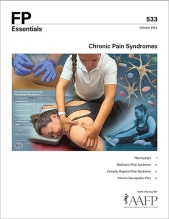
This clinical content conforms to AAFP criteria for CME.
Neuropathic pain affects 7% to 10% of the population and has major effects on quality of life. It is defined as pain caused by a lesion or disease of the somatosensory nervous system and may be central or peripheral. Diagnostic testing may yield inconclusive or inconsistent results, so physicians often rely on clinical judgment based on the history and physical examination findings. Questionnaires and scoring systems can aid in diagnosis. Neuropathic pain is differentiated from other types of chronic pain by abnormal sensory symptoms, such as shooting pain, burning pain, or numbness. It is difficult to manage and can be accompanied by mood and sleep disturbances. Referral for psychotherapy may be useful for these patients. Nonpharmacotherapy options include mindfulness training, transcutaneous electrical nerve stimulation, and massage. Acupuncture also may be effective, but the data are mixed. Topical drugs (eg, lidocaine, capsaicin), gabapentinoids, tricyclic antidepressants, and serotonin-norepinephrine reuptake inhibitors are considered first-line drugs. Tramadol is considered a second-line drug, but may considered first-line for certain patients. For persistent pain, physicians can consider referring patients to a pain specialist for nerve blocks or other procedural interventions. Opioids may be considered for refractory pain, but their additional benefit has been shown to be modest compared with those of other treatments.
Case 4. RR is a 68-year-old patient with hypertension, hyperlipidemia, and noninsulin-dependent type 2 diabetes who reports pain in his legs and feet. He says the pain is intermittent and feels like deep burning pain with episodes of numbness and tingling. He rates it as 6 on a 10-point scale. The pain is worse when lying still, particularly in the evening, and is brought on by cold weather and light touch. RR takes metformin and empagliflozin (Jardiance) for diabetes management. The most recent A1c level was 8.6%. In addition, he has a history of posttraumatic stress disorder and feels this pain is contributing to worsening anxiety and insomnia.
Subscribe
From $350- Immediate, unlimited access to FP Essentials content
- 60 CME credits/year
- AAFP app access
- Print delivery available
Edition Access
$44- Immediate, unlimited access to this edition's content
- 5 CME credits
- AAFP app access
- Print delivery available
